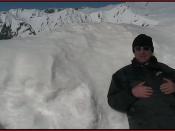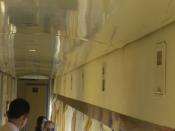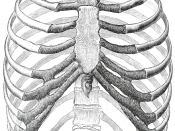Gas exchange or respiration in humans is the means by which getting oxygen from air into the blood and carbon dioxide out of the blood into the air. Humans must exchange these gases with the environment because oxygen is essential for cells, which use this vital substance to release the energy needed for cellular activities. In addition to supplying oxygen, carbon dioxide needs to be removed in order to prevent the buildup of this waste product in the body tissues. As breathing is the act or process of respiration, it consists of two phases, inspiration and expiration. During inspiration, the diaphragm moves downward increasing the volume of the thoracic cavity, and the intercostal muscles contract, which makes the rib cage move upward and forward increasing the volume of the lungs. The increase in pressure inside the lungs makes the air from the atmosphere move into the lungs because air always moves from an area of high pressure to a low pressure area.
During expiration, the intercostal muscles that lift the rib cage and the diaphragm relax. As a result, the rib cage and the diaphragm return to their original positions and the lungs contract with them. With each contraction of the lungs, the air inside them is forced out.
Inhaled air consists of 79.02% nitrogen and other trace gases, 20.94% oxygen and 0.04% carbon dioxide. Humans breathe in by increasing the volume in the chest cavity, thereby reducing the pressure in the lungs below atmospheric pressure. The higher pressure of the external air forces air to get in through the nose and mouth and down a tube called the trachea. The trachea forks to form two tubes called the bronchi, each of which branches into numerous bronchioles. From there, the bronchioles eventually lead to tiny air sacs called alveoli. Gas exchange occurs at the level of the alveoli. The purpose of gas exchange is to get the oxygen to every cell of the body where the oxygen is used to produce ATP energy in the mitochondria of the cells. The capillaries that surrounded the alveoli are involved in gas exchange between alveoli and blood. Oxygen diffuses from the alveoli into the blood and carbon dioxide, that is produced when the cells break down nutrients, passes from the blood into the alveoli ..
An adult normally breathes from 14 to 20 times per minute and breathes in and out about 500 mL of air 15 times a minute. The breathing rate, or the lung capacity, is affected by various factors including anatomical build, age, dispensability of the lungs, and the presence of respiratory diseases. A person can alter the rate of breathing and can even stop breathing for only a short time as it is impossible to stop breathing permanently. The reason for that is because breathing, like the heartbeat, is an involuntary activity that is controlled by nerve centers in the lower part of the brain. These centers are connected with the muscles of the rib cage and the diaphragm. Their function is to increase or decrease the rate of breathing according to the needs of the body. The more physically active the body is the more ATP energy is required. Therefore, to produce more ATP energy more oxygen must be inhaled, and therefore the vital capacity will be increased.
The amount of air taken into the lungs in a single breath is called the tidal volume. In adults the tidal volume is about 0.5 liters. The lungs can hold about ten times this volume if they are filled to capacity. This maximum amount which is called ''the vital capacity'' is generally about 4.8 liters in an adult male, but varies from one individual to the next. For example, athletes can have a vital capacity of as much as 5.7 liters. Therefore, the vital capacity is reached only during strenuous exercise.


